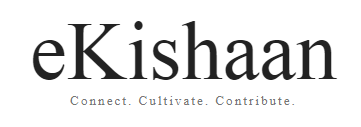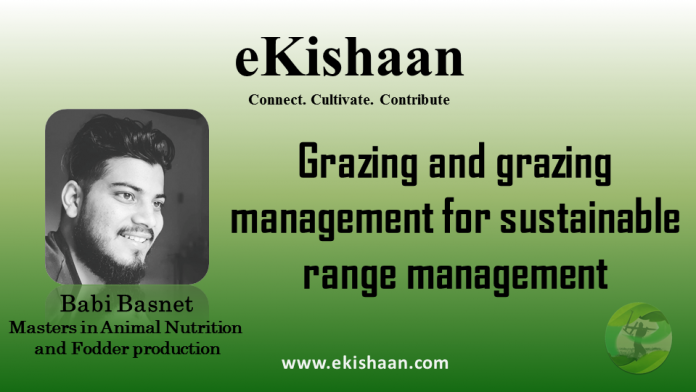Grazing and grazing management for sustainable range management
Grazing has two distinct meanings. First, grazing is a method of feeding in which a herbivore feeds on plants such as grasses, or other multi-cellular organisms such as algae.
Second, grazing is a method of agriculture in which domestic livestock are used to convert grass and other forage into meat, milk and other products.
The manipulation of the soil-plant-animal complex of grazing land in pursuit of a desired result is called grazing management. It consists of wise and skillful manipulation of two basic biological elements:
- Pasture area
- Grazing animals
The principal factors that are under the direct control of the manager includes:
- Choice of the species
- Manipulation of agronomic practices
- Selection of livestock feeding
- Use of supplementary feeding
- Choice of the grazing system.
Objective of grazing management system:
- To restore the plant vigour
- To allow plants to produce seeds
- To accomplish uniform utilization of forage
- To maintain animal productivity
- To maintain ecological stability
The grazing management systems for sustainable range management are as follows:
-
Continuous grazing system:
- It is extensive grazing in which the stocks are grazed in the same grazing area over a prolonged period of time. After a long period of continuous grazing with high stocking rate pasture deteriorates is the common. It changes the species composition/succession (favorable for thorn like plants). This is common practice in Nepal.
Advantages:
- Requires less management.
- Capital costs are minimal.
Disadvantages:
- Lower forage quality and yields.
- Lower stocking rate and less forage produced per acre.
- Uneven pasture use.
- Greater forage losses due to trampling.
- Animal manure is distributed unevenly.
- Weeds and other undesirable plants may be a problem.
-
Rotational grazing system
- It is an intensive system of grazing in which stocks are grazed in the different area of the rangeland moving from one part to another in rotation. The aim of this system of grazing is to use the grassland when it is young and highly nutritious and then allow an adequate recovery period.
Advantages:
- Can increase forage production and improve pasture condition.
- Allows pastures to rest and allows for forage re growth.
- Can provide a longer grazing season, reducing the need for feeding harvested forages.
- Better distribution of manure throughout the pasture.
Disadvantages:
- Costs for fencing and water systems can be higher than with continuous grazing.
- Forage production and pasture utilization is not as high as intensive rotational grazing systems
-
Deferred grazing system:
- In this system, grazing is delayed until after the most important species have seed, rhizomes, etc for reproduction and propagation. Grazing land vegetation allows growing fully, root systems are allowed to develop and self sown seeds established. This practice is beneficial for improving degraded pasture and for the conservation of endangered range vegetation.
-
Controlled grazing system:
- Controlled grazing gives the producer more control over grazing animals. The grazing area can be increased when forage growth is slow or it can be decreased when forage growth is fast. Forage growth is measured by taking the height of the pasture. Controlled grazing requires the manager to check pasture growth daily and have additional land for pasture.
Advantage of controlled grazing:
- More produced forage is used.
- Higher number of animals can be supported.
- More meat/milk is produced per unit of land.
-
Strip grazing:
- Strip grazing is a grazing management system that involves giving livestock a fresh allocation of pasture each day. It is usually organized within a paddock grazing system and the animals are controlled by the use of an electric fence. Fences are moved once or twice daily to provide fresh forage. This is the most labor-intensive. Strip grazing also results in the highest quality of feed and the least waste.
-
Creep Grazing:
- Creep grazing is when young nursing animals are given forward access to fresh, ungrazed pasture through an opening in the fence. To be effective, the forage in the creep area must be superior to the forage in the non-creep area. The greater difference between forages in the two areas means the greatest benefit to creep grazing. In addition to better nutrition in the fresh paddock, infection with infective worm larvae will be lower.
-
Forward grazing:
- It is where the pasture is grazed by two groups of animals. The first group to enter the pasture is those with higher nutritional needs (e.g. ewes with lambs and grazes the top of the plants. The second group, with lower nutrient requirements (e.g. dry ewew), grazes what is left by the first group. This allows for higher weaning weights when forages is limited or where competition between young stock and dams exist.
-
Seasonal Grazing:
- Seasonal grazing incorporates “grazing animals on particular area for only part of thye year”. This allows the land that is not being grazed to rest and allow for new forage to grow.

